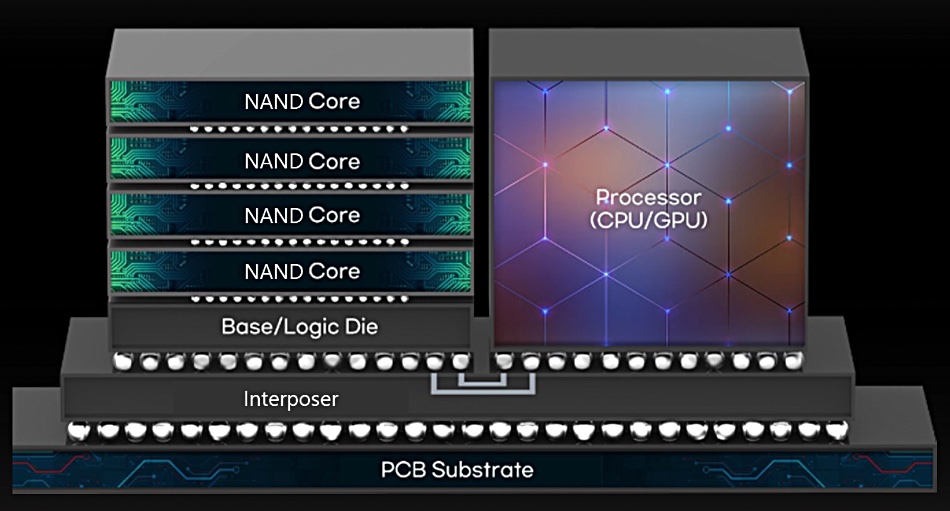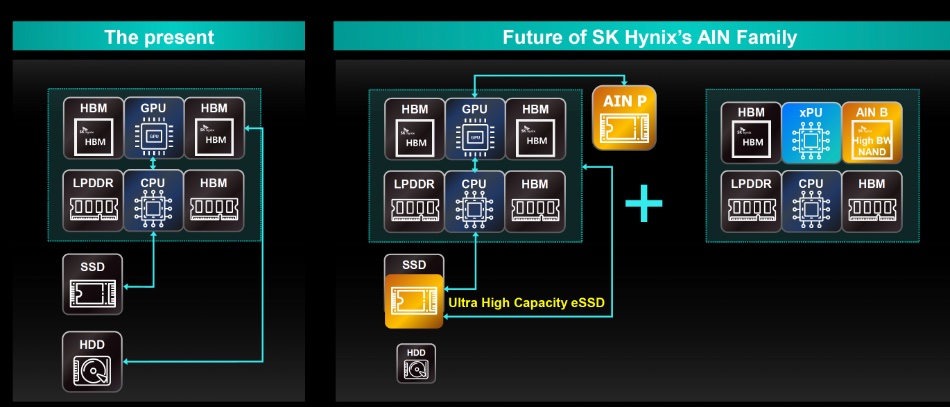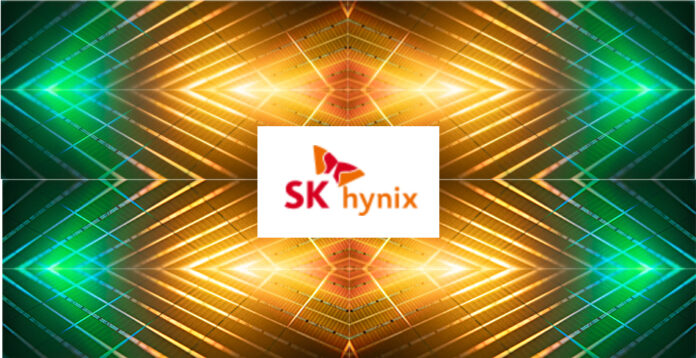SK hynix is extending its NAND technology in three directions; speed, capacity, and bandwidth, to meet AI data storage performance and data volume needs.
AIN (AI NAND) is SK hynix’s AI NAND strategy, with performance (AIN P), density (AIN D) and bandwidth (AIN B) product development directions. AIN P drives will process large volume data generated by large-scale AI inference workloads. Petabyte-class AIN D SSDs are intended to replace disk drives by storing large amounts of AI data with low power consumption and cost with SSD speed and HDD cost-efficiency.

AIN-B flash memory is the high-bandwidth flash (HBF) concept of stacking flash dies above an interposer which connects them, as they operate in parallel, to a GPU. This AIN product initiative was presented at the ‘2025 OCP (Open Compute Project) Global Summit’, held in San Jose, California.
Sk hynix is looking specifically at AI inferencing and sees different NAND drive requirements at different stages of the inferencing work flow;

The slide doesn’t show a background need for high-volume AI Inferencing data storage, but that needs to exist as well in SK hynix’s view of the AI inferencing data universe.
The AIN P drive is envisaged as a PCIe Gen6 drive capable of 50 million IOPS with a 512B data access chunk, which compares to the 4KB block used currently for random read and write IOPS, which run at the 7 million IOPS level for PCIe gen 6 SSDs, according to an SK hynix slide. Our files record Micron’s 9650 Pro and Max PCIe Gen 6 drive operating at 5.5 million random red IOPS. SK hynix must know faster PCIe gen 6 drives are coming. Its AIN P drive will be 7x faster than them and, SK hynix says, a 100 million IOPS model could be available in 2027. This is far beyond any performance level put out by its competitors.
It will have a controller designed to execute both conventional and high-IOPS workloads and be built with an EDSFF E3.x form factor. SK hynix is designing AIN P NAND samples and hopes they’ll be ready by the end of 2026.
AIN B NAND uses HBF (High Bandwidth Flash) technology.

SK hynix says AIN B will have higher throughput than an SSD and be more or less equivalent to high-bandwidth memory (HBM) which uses a similar stacked die concept only for DRAM. The AIN B product will have higher capacity than HBM, being approximately at SSD capacity levels. AIN B can bulk out the effective memory capacity of a GPU and so obviate a need to buy/rent more GPUs to get more HBM capacity, storing KV Cache contents for example.
This HBF stack could be co-located with an HBM stack, sharing the same interposer base. SK hynix and Sandisk are working to promote an HBF standard.
The AIN D disk replacement SSD will have petabyte class capacity, and an SK hynix slide graphic shows its position in a memory-storage hierarchy;

It’s called a Nearline (NL) SSD and the slide text mentions “JEDEC-NLF” with JEDEC being a semiconductor standards body and NLF denoting, we understand Near Line Flash. There is no public JEDEC NLF standard so this is, presumably, a work in progress. The graphic does not mention PLC (5 bits/cell) NAND so we might assume, for the time being, that the NL-SSD uses QLC flash.
There is no time scale given for its arrival.
An SK hynix slide shows where its AIN product family will fit in a data center;

It’s a neat and logical picture. But …
Comment
Looking at SK hynix’ NAND roadmap it is as if its subsidiary, Solidigm, does not exist. The AIN D high capacity eSSD seems independent of Solidigm’s high-capacity, QLC SSD technology. In fact Solidigm pioneered the high-capacity, near line-class SSD with its D5-P5336 192L QLC 61.44 and 122.88 TB drives [PCIe Gen 4]. Solidigm has a roadmap including >2XX layer count, and a 245 TB QLC SSD, which it anticipates shipping by the end of 2026.
SK hynix’ AIN-D high-capacity and low cost SSD is meant to replace HDDs.
The company implies a JEDEC NL-SSD standard will exist, but JEDEC hasn’t publicly said anything about this. Nor does SK hynix mention PLC NAND as a technology for this SSD. Neither does it provide any capacity numbers, such as 245 TB. The spokesperson subsequently told us: “At this point, we cannot comment on the capacity of the product since it is only under development status.”
The company has said that it’s beginning mass production of a 321-layer, QLC 2 Tb die, the world’s first implementation of more than 300 layers using QLC technology, with product shipping in the first half of 2026. This follows announcements of a 256 TB Sandisk UltraQLC SN670 SSD and 245.8 TB Kioxia LC9 SSD, both of which use the two joint-venture partner’s 2 Tb QLC (4 bits/cell) die fabricated from 218-layer 3D NAND.
We have asked SK hynix about its positioning of high-capacity Solidigm SSDs in the market and a company spokesperson told us: “AIN D is expected to expand the market by differentiating itself from existing NAND storage, such as SSDs, through low power consumption, low cost, and high capacity.”








